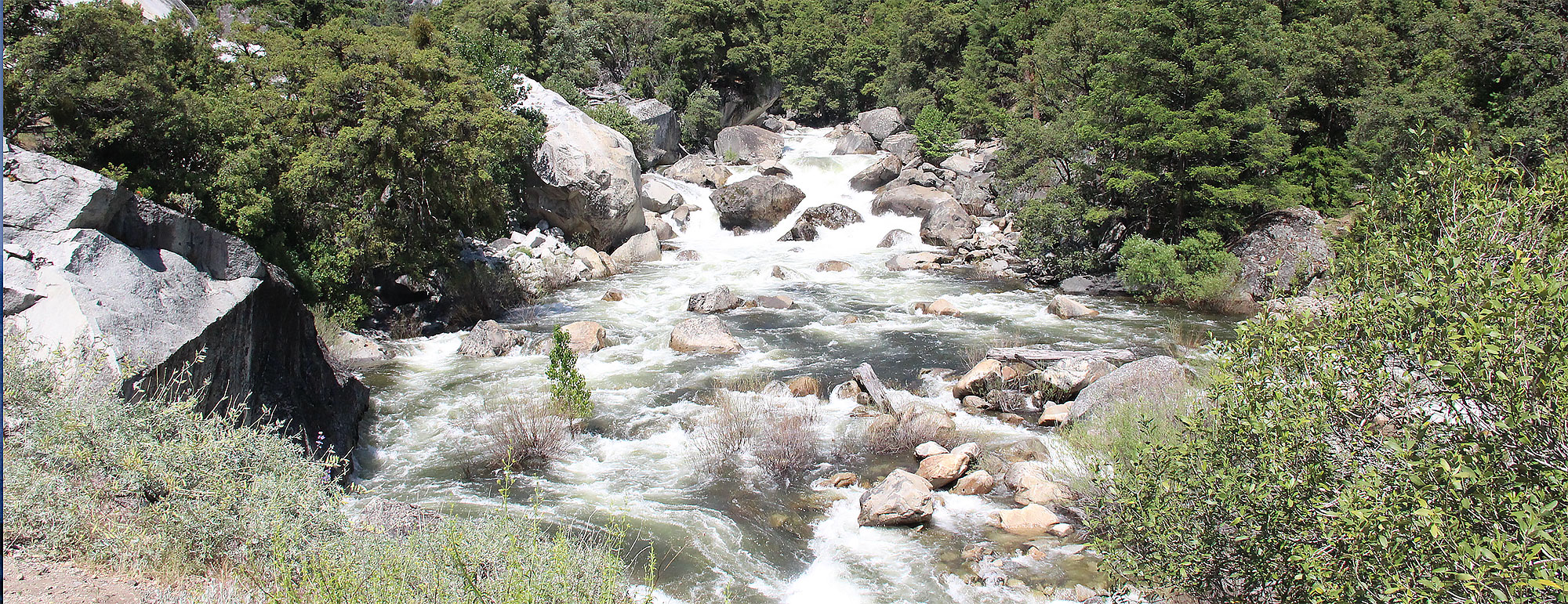D.W. Webb†, M.J. Wetzel, and L.R. Phillippe
Illinois Natural History Survey (INHS)
1816 S. Oak Street, Champaign, IL 61820
P.C. Reed and T.C. Young
Illinois State Geological Survey
615 East Peabody Drive, Champaign, IL 61820
This webpage provides an overview of our intensive study focusing on the biodiversity, water quality, and hydrogeology of springs in Illinois, USA, conducted in three phases from April 1991 through June 1997. An introduction to this project is followed by links to summaries for each of the three studies, including citations for published papers and project reports resulting from this research. We are currently preparing historical information, biological data, and results of water quality analyses obtained during this study for publication in an INHS Bulletin on the Springs of Illinois.

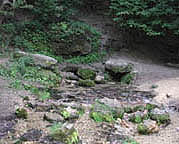
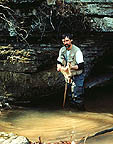
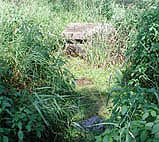
Introduction
Springs are a natural source of groundwater discharge at a rate high enough to form a channel on the earth’s surface. The physical and chemical composition of spring water reflects not only the mineral composition of the various rock strata with which the water has been in contact, but also the various chemicals that percolate into ground water. Even though springs provide a unique interface between ground water and surface water, they have only recently become a focal point of research in Illinois.
Along with their associated seeps and outflow brooks, springs provide a unique habitat for endemic species (organisms restricted to a localized area) of animals and plants because they usually provide a nearly constant physical and chemical environment. Until recently, little emphasis in Illinois had been given to the study of springs, particularly from the perspective of species richness and endemism in relation to water quality. Past studies of springs generally focused on a selected taxonomic group, but provided minimal water quality information other than water temperature, dissolved oxygen, hydrogen ion concentration (as pH) and alkalinity. Aquatic macroinvertebrates of temperate, cold water areas are dominated by either a non-insectan community (Turbellaria, Annelida, Amphipoda, Isopoda, Gastropoda) or an aquatic insect community (Odonata, Ephemeroptera, Plecoptera, aquatic Diptera, Trichoptera, and aquatic Coleoptera). Faunal dominance by non-insect species appears in hard water limestone springs with a pH >7.0 and alkalinity above 25 mg/L (as CaCO3). Aquatic insects appear to dominate the fauna in both acidic and soft water springs – those with a pH <7.0, and those with an alkalinity below 25 mg/L, respectively. Both types of springs occur in Illinois, providing an opportunity to evaluate the species richness and endemism of aquatic macroinvertebrates in relation to water quality.
With the passage of the Clean Water Act of 1972, which called for state funding for ground water management and water quality programs, states were required develop biological criteria for the protection of aquatic communities. As recently as 1990, baseline information on the fauna, flora, water quality, and hydrogeology was virtually nonexistent for springs in Illinois.
A cooperative program between the Illinois Natural History Survey and the Illinois State Geological Survey was initiated in 1991 to evaluate the current status of Illinois springs – in particular, the groundwater quality and biota associated with them. Many locations of springs were determined from topographic maps; additional locations were provided by residents and landowners throughout the state. Funding from several agencies in the State of Illinois provided support for this research, conducted in three phases (summarized below).
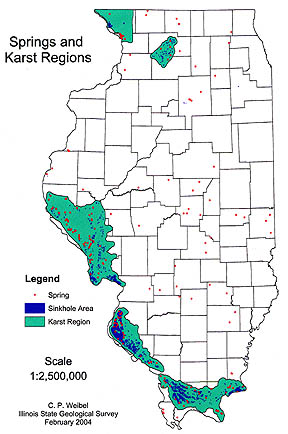
The majority of springs in Illinois are located in the Mississippian, Devonian, and Pennsylvanian limestone and sandstone of the Shawnee Hills of southern Illinois and along the western border of the state, extending north to the Driftless area of Carroll and Jo Daviess counties. Several springs also originate from the base of the bluffs along the Fox, Illinois, and Rock rivers. Only a modest number of springs, however, occur in the central plains of Illinois.All information resulting from these studies of Illinois springs is being entered into a computerized database; to date, information on over 300 springs has been included. This study will allow us to complete an assessment of the community diversity of aquatic macroinvertebrates associated with springs in this state, and the relationship of the overall groundwater chemistry with those populations. We currently are compiling the information from this long-term project for publication in the Illinois Natural History Survey Bulletin.
The first phase of this project was conducted from April 1991 through April 1992. During this initial study, seven springs located in the Shawnee Hills of Gallatin, Hardin, Jackson, and Union counties in southern Illinois were surveyed for aquatic macroinvertebrates, aquatic plants, and water quality. Funding for this first phase of our Springs of Illinois project were provided in part by the Illinois Nature Preserves Commission [Project Officer: Brian Anderson].
The second phase of this project was conducted from November 1994 through August 1995. During this second study, 10 karst springs located in the Salem Plateau Section in St. Clair and Monroe counties, southwestern Illinois, were surveyed for aquatic macroinvertebrates, aquatic and riparian vegetation, and water quality. Funding for this second phase of our Springs of Illinois project were provided in part by the Illinois Groundwater Consortium (Office of Research Development and Administration, Southern Illinois University, Carbondale). A short article with pictures published in the May/June 1997 issue of INHS Reports provided a short summary of this Springs of Illinois project through 1996.
The third phase of this project was conducted from September 1995 through June 1997. During this third study, 125 springs located in the Lincoln Hills, Driftless, and Till Plains sections of western and northern Illinois (26 counties) were visited; aquatic macroinvertebrates and water samples were collected at 58 of these springs. Surveys for aquatic and riparian vegetation associated with these springs also were also completed. Funding for this third phase of our Springs of Illinois project were provided in part by the Environmental Protection Trust Fund Commission and the Illinois Department of Energy & Natural Resources.
Acknowledgements
Funding for this research was graciously provided by the Illinois Nature Preserves Commission, Illinois Groundwater Consortium, Illinois Environmental Protection Trust Fund Commission, Illinois Department of Natural Resources, and the U.S. Department of Agriculture.
As with any multidisciplinary research program, our project objectives could not have been realized without the interest, assistance, and expertise of numerous colleagues – M.L. Biyal, V.J. Bohlen, P.A. Ceas, K.S. Cummings, C.L. Dassler, R.E. DeWalt, W.C. Handel, M. Harper, M.A. Harris, J. Jawad, B.J. Kasprowicz, D.M. Ketzner, E.N. Knight, K. Kramer, J.K. Krejca, E.S. Lancaster, M.J. Lancaster, M. Lusk, L.M. Page, C.A. Phillips, T.E. Rice, K.R. Robertson, J.D. Sandberger, C.A. Taylor, S.J. Taylor, C.E. Warwick, M.L. Williamson†, E.R. Wohlgemuth, A.M. Young, H. Zhang, and S. Braxton (Illinois Natural History Survey); J.W. Baxter, R.A. Cahill, S.J. Chou, B.B. Curry, J.M. Dexter, R R. Frost, K.C. Hackley, M.W. Knapp, Z. Lasemi, C.Liu, J.M. Masters, D.M. Moore, R.D. Norby, P. Orozco, S.V. Panno, J.D. Steele, W.M. Wendland, and C.P. Weibel (Illinois State Geological Survey); B. Kaiser and others (Illinois State Water Survey, Office of Analytical & Water treatment Services); Brian Anderson (Illinois Nature Preserves Commission, Illinois Department of Natural Resources); J.D. Bade (Monroe-Randolph Bi-County Health Department); J. Ely (Southern Illinois University, Carbondale); A.M. Hampton (Castleton State College, Vermont); B.-I. Henrikson (Göteborgs Universitet, Sweden); W.N. McKnight (Park Tudor School, Indianapolis, Indiana); B.B. Miller (Kent State University, Ohio); A. Nilsson (Umeå Universitet, Sweden); K.A. Coates (Bermuda); and K.A. Schmude (University of Wisconsin-Superior).
Finally, we extend our appreciation to the numerous land owners in Illinois who kindly provided historical information for and access to spring habitats on their properties; we could not have conducted this study without their extensive assistance, courtesy, and trust in us to conduct our research in a ‘low-impact’ approach. We especially commend Illinois land owners for their long-term stewardship of these sensitive and unique groundwater systems.
Publications resulting from this research to date
Webb, D.W., M.J. Wetzel, P.C. Reed, L.R. Phillippe, and M.A. Harris. 1995. Aquatic biodiversity in Illinois springs. Journal of the Kansas Entomological Society 68(2)suppl.: 93-107.
Webb, D.W., M.J. Wetzel, P.C. Reed, L.R. Phillippe, and T.C. Young. 1998. The macro-invertebrate biodiversity, water quality, and hydrogeology of ten karst springs in the Salem Plateau Section of Illinois, USA. Pages 39-48, In: L. Botosaneanu (ed.). Studies in Crenobiology – The biology of springs and springbrooks. Backhuys Publishers, Leiden, The Netherlands. 261 pp. ISBN 90-73348-04-8.
Questions, Comments, Suggestions, or Ideas?
Please e-mail them to me at mjwetzel{AT}illinois.edu
Copyright © 1990–2023, by Mark J. Wetzel and Don W. Webb † (Illinois Natural History Survey, Champaign) unless otherwise noted; All Rights Reserved. This website contains original, copyrighted material; it is being provided here as a professional courtesy, exclusively for your private, non-commercial use. Reference to or redistribution of any part of the information contained herein – whether it be through oral, printed, electronic, or other tangible medium of expression – shall acknowledge the Illinois Natural History Survey (INHS), the Illinois State Geological Survey (ISGS), The Illinois Department of Natural Resources, and this website as its source. Should you have any questions whatsoever regarding the warranty, liability, or proprietary rights of, or credits for information contained within this website, please refer to the INHS License Agreement. [To the best of my knowledge – and with the exception of the INHS logo – all icons, line breaks, dots, arrows, and globes are not copyrighted.]
Suggested citation for this electronic website:
Wetzel, M.J., and D.W. Webb. 2007–2024.
Springs of Illinois homepage. World Wide Web URL:
[ https://www.inhs.illinois.edu/people/mjwetzel/springs ] 17mar2024.
Please also visit our institutional websites:
Illinois Natural History Survey
and the
Illinois State Geological Survey
Return to top of this page.
